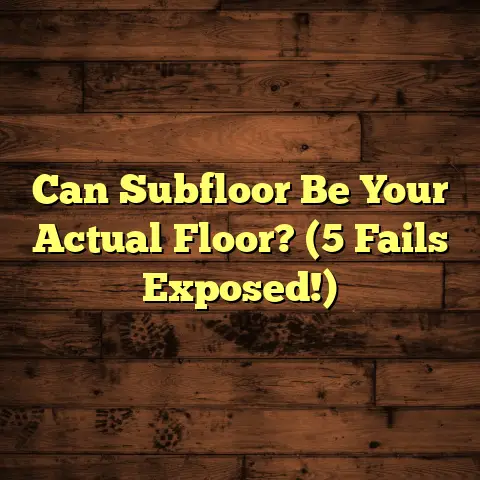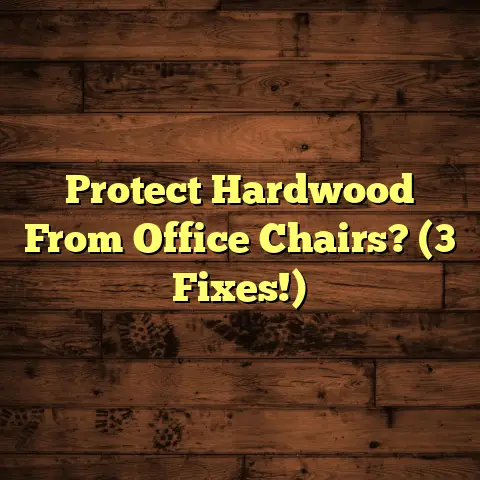Why Is My Hardwood Floor Buckling? (1 Cause Exposed!)
Hardwood floors, right?
They’re the pièce de résistance of so many homes.
I’ve seen them transform spaces from drab to absolutely stunning.
They bring warmth, elegance, and a certain je ne sais quoi that other flooring types just can’t match.
Plus, they’re durable!
But let’s be honest, they’re also a bit of an investment.
And like any investment, you want to protect it.
One of the most disheartening things I see as a flooring contractor is a beautiful hardwood floor that’s… well, buckling.
It’s like watching a masterpiece slowly crumble.
And it’s not just about looks.
Buckling can affect your home’s acoustics too!
Think about it: a flat, solid hardwood floor helps absorb sound, reducing echoes and creating a more peaceful environment.
When boards start to lift and warp, that sound absorption is compromised.
Suddenly, your once-tranquil living room starts to sound like a gymnasium.
I’m here to tell you why this happens and, more importantly, what you can do about it.
In this article, I’m going to dive deep into the #1 culprit behind hardwood floor buckling: moisture imbalance.
I’ll break it down in a way that’s easy to understand, even if you’re not a flooring expert.
Trust me, understanding this one thing can save you a ton of headaches (and money!) down the road.
So, grab a cup of coffee, settle in, and let’s get to the bottom of this buckling mystery!
Section 1: Understanding Hardwood Flooring
Okay, let’s start with the basics.
Not all hardwood floors are created equal.
Understanding the different types and installation methods is crucial for understanding why buckling happens.
Solid vs. Engineered Hardwood: What’s the Difference?
Think of solid hardwood as the OG of flooring.
It’s a single piece of wood, milled from a tree.
It’s beautiful, durable, and can be refinished multiple times.
But, because it’s a single piece of wood, it’s also more susceptible to moisture changes.
Engineered hardwood, on the other hand, is made up of multiple layers of wood veneer glued together.
The top layer is a hardwood veneer, giving you the same look and feel as solid hardwood.
The layers underneath are typically made of plywood or other composite materials.
This multi-layered construction makes engineered hardwood more dimensionally stable than solid hardwood.
Meaning, it’s less likely to expand and contract with changes in humidity.
As a rule of thumb, here is a table showing the differences:
Installation Methods: How They Affect Performance
How your hardwood floor is installed also plays a big role in its long-term performance.
There are three main installation methods:
Nail-Down: This is the most common method for solid hardwood.
The boards are nailed directly to the subfloor.-
Glue-Down: This method is often used for engineered hardwood and involves gluing the boards directly to the subfloor.
-
Floating: This method is typically used for engineered hardwood and involves clicking the boards together to create a “floating” floor that is not attached to the subfloor.
Each method has its pros and cons, but the key takeaway here is that proper installation is essential to prevent buckling.
Improper nailing, insufficient glue, or inadequate expansion gaps can all contribute to moisture-related issues.
The Beauty and Benefits of Hardwood
Beyond the technical stuff, let’s not forget why we love hardwood floors in the first place!
They add a touch of elegance and sophistication to any home.
They increase property value, and when sourced sustainably, they’re an eco-friendly choice.
I’ve seen firsthand how a well-maintained hardwood floor can become a focal point of a home, a source of pride for the homeowner.
However, it’s important to remember that wood is a natural material.
It reacts to its environment.
It expands and contracts with changes in temperature and humidity.
This natural movement is normal, but when it becomes excessive, that’s when you start to see problems like buckling.
Section 2: What is Buckling?
Alright, let’s get down to brass tacks: What exactly is buckling?
In the context of hardwood flooring, buckling refers to the lifting or warping of the wood boards, causing them to rise above the level of the surrounding floor.
It’s not just a cosmetic issue.
It can create tripping hazards, damage furniture, and even compromise the structural integrity of your floor.
Different Forms of Buckling: Crowning, Cupping, and Warping
Buckling can manifest in several different ways, each with its own distinct appearance:
Crowning: This occurs when the center of the board is higher than the edges, creating a convex shape.
It’s often caused by moisture accumulating on the surface of the board.Cupping: This is the opposite of crowning.
The edges of the board are higher than the center, creating a concave shape.
It’s often caused by moisture accumulating on the underside of the board.Warping: This is a more general term that refers to any distortion of the board, including twisting, bending, or bowing.
It can be caused by a variety of factors, including uneven moisture distribution and internal stresses within the wood.
To illustrate, here’s a table:
The Physics of Buckling: Expansion and Contraction
So, what’s actually happening at a physical level when a hardwood floor buckles?
It all comes down to the expansion and contraction of wood in response to moisture changes.
Wood is a hygroscopic material, meaning it readily absorbs and releases moisture from the surrounding air.
When wood absorbs moisture, it swells. When it loses moisture, it shrinks.
If the wood absorbs too much moisture, it can expand to the point where it no longer fits snugly against the adjacent boards.
This creates pressure, which can cause the boards to lift or warp, resulting in buckling.
Think of it like trying to squeeze too many people onto a crowded subway car.
Eventually, someone’s going to get pushed out of place!
Section 3: The Main Cause of Buckling
Okay, we’ve laid the groundwork.
Now, let’s get to the heart of the matter: the primary cause of buckling is moisture imbalance.
I can’t stress this enough.
In my years of experience, I’ve seen countless cases of buckling, and in almost every single one, moisture was the underlying culprit.
How Moisture Enters the Picture
Excessive moisture can find its way into your hardwood floor in a variety of ways:
Flooding: This is the most obvious source of moisture.
A burst pipe, a leaky roof, or a natural disaster can all inundate your floor with water.Leaks: Even small, undetected leaks can cause significant damage over time.
Leaky plumbing, dripping faucets, or condensation from air conditioning units can all contribute to moisture buildup.High Humidity: In humid climates, the air itself can be a source of moisture.
If your home is not properly ventilated, the humidity can penetrate the wood and cause it to swell.
The Science Behind Wood and Moisture
To truly understand why moisture is such a problem, you need to understand a little bit about the cellular structure of wood.
Wood is made up of tiny cells that act like miniature sponges.
These cells absorb and release moisture, causing the wood to expand and contract.
When wood absorbs too much moisture, the cells become saturated, and the wood can swell to the point where it exceeds its original dimensions.
This swelling creates internal stresses within the wood, which can lead to buckling.
Environmental Conditions That Exacerbate Moisture Issues
Certain environmental conditions can make moisture problems even worse:
Seasonal Changes: In many parts of the country, humidity levels fluctuate dramatically throughout the year.
In the summer, humidity is high, and wood tends to swell.
In the winter, humidity is low, and wood tends to shrink.
These seasonal changes can put a lot of stress on your hardwood floor.Poor Ventilation: Proper ventilation is essential for maintaining a healthy indoor environment.
If your home is not properly ventilated, moisture can build up, especially in areas like bathrooms and kitchens.Use of Humidifiers/Dehumidifiers: While humidifiers and dehumidifiers can be helpful for controlling indoor humidity, they can also cause problems if they’re not used properly.
Over-humidifying your home can lead to excessive moisture in your hardwood floor, while over-dehumidifying can cause the wood to dry out and crack.
Real-Life Examples: Moisture Gone Wild
I’ve seen it all.
I remember one case where a homeowner had a slow, undetected leak under their kitchen sink.
Over time, the water seeped into the subfloor and eventually made its way into the hardwood flooring.
The result? A large section of the floor buckled, requiring extensive repairs.
Another time, I was called to a home in a coastal area with high humidity.
The homeowners didn’t have proper ventilation in their crawl space, which led to moisture buildup and, you guessed it, buckling.
These are just a few examples of how moisture can wreak havoc on hardwood floors.
The Role of Installation Practices
Finally, let’s talk about installation practices.
Even if you have the best quality hardwood flooring, improper installation can exacerbate moisture problems.
Two key areas to consider are:
Insufficient Acclimation: Before installing hardwood flooring, it’s crucial to allow it to acclimate to the environment in your home.
This means storing the flooring in the room where it will be installed for several days or even weeks to allow it to adjust to the temperature and humidity levels.
Skipping this step can lead to excessive expansion and contraction after installation.Improper Sealing: Proper sealing is essential for protecting your hardwood floor from moisture.
Make sure the floor is properly sealed with a high-quality finish that is designed to resist water damage.
Section 4: Secondary Causes of Buckling
While moisture imbalance is the primary cause of buckling, it’s important to acknowledge that other factors can contribute to the problem.
Think of these as “secondary” causes that can exacerbate the effects of moisture or, in some cases, cause buckling on their own.
Improper Installation: A Recipe for Disaster
I touched on this earlier, but it’s worth reiterating: improper installation can be a major headache.
Things like insufficient nailing, inadequate glue, or uneven subfloors can all create weak points in your flooring system, making it more susceptible to buckling.
Lack of Expansion Gaps: Giving Wood Room to Breathe
Remember how I said wood expands and contracts?
Well, if you don’t leave enough space around the perimeter of the room (called expansion gaps), the wood won’t have room to move.
This can create tremendous pressure, leading to buckling, especially during periods of high humidity.
As a general rule, a 1/4 to 1/2 inch expansion gap is recommended.
Changes in Subfloor Conditions: A Hidden Problem
The subfloor is the foundation upon which your hardwood floor rests.
If the subfloor is uneven, damaged, or contains excessive moisture, it can create problems for your hardwood floor.
For example, if the subfloor is damp, it can transfer moisture to the hardwood, causing it to swell and buckle.
Temperature Fluctuations: A Minor Player
While temperature fluctuations can play a role in flooring movement, they are generally less significant than moisture changes.
However, extreme temperature swings can still put stress on your hardwood floor, especially if it’s already compromised by moisture issues.
The Compounded Effect: When Secondary Causes Join Forces
The real danger lies in the compounded effect of these secondary causes.
For example, if you have a leaky pipe and insufficient expansion gaps, the moisture will have an even greater impact on your floor, leading to more severe buckling.
Section 5: Identifying and Diagnosing the Problem
Okay, so you suspect your hardwood floor might be buckling.
What do you do?
The first step is to identify the signs of buckling.
Look for:
- Visible lifting or warping of the boards
- Gaps between the boards
- Squeaking or creaking when you walk on the floor
- A spongy or uneven feel underfoot
If you notice any of these signs, it’s time to start investigating.
Diagnostic Steps: Becoming a Flooring Detective
Here are some steps you can take to diagnose the cause of the buckling:
Check for Leaks: This is the most obvious step, but it’s important to be thorough.
Look for leaks around plumbing fixtures, appliances, and windows.
Also, check for signs of water damage on the ceiling or walls.Examine Humidity Levels: Use a hygrometer to measure the humidity level in your home.
Ideally, the humidity should be between 30% and 50%.
If the humidity is consistently above 60%, you may have a moisture problem.Inspect for Gaps or Loose Boards: Pay close attention to the perimeter of the room.
Are there adequate expansion gaps?
Are any of the boards loose or damaged?
Tools and Methods for Measuring Moisture
To get a more accurate assessment of the moisture levels in your flooring, you can use a moisture meter.
There are two main types of moisture meters:
Pin Meters: These meters use two pins that are inserted into the wood to measure the electrical resistance.
The higher the moisture content, the lower the resistance.Pinless Meters: These meters use electromagnetic waves to measure the moisture content without penetrating the wood.
They are less invasive than pin meters, but they may not be as accurate.
When to Call a Pro: Knowing Your Limits
While you can do some initial troubleshooting on your own, it’s important to know when to call in a professional.
If you’re not comfortable using a moisture meter, or if you suspect a serious moisture problem, it’s best to consult with a qualified flooring contractor.
A professional can accurately assess the extent of the damage, identify the source of the moisture, and recommend the best course of action.
Section 6: Long-Term Implications of Buckling
Ignoring buckling in your hardwood floor is like ignoring a toothache.
It might not seem like a big deal at first, but it will only get worse over time.
Further Damage and Increased Repair Costs
If you don’t address the underlying cause of the buckling, the problem will continue to worsen.
The boards will become more warped and damaged, and the subfloor may also be affected.
Eventually, you may need to replace the entire floor, which can be a very expensive proposition.
Impact on Home Value
A buckled hardwood floor is a major red flag for potential buyers.
It can significantly detract from the value of your home and make it more difficult to sell.
Consequences on Structural Integrity
In severe cases, buckling can even compromise the structural integrity of your flooring system.
If the subfloor is severely damaged, it can weaken the entire floor, making it unsafe to walk on.
Timely Intervention: The Key to Saving Your Floor
The key takeaway here is that timely intervention is crucial.
The sooner you address the buckling, the less damage it will cause and the lower the repair costs will be.
Conclusion
So, there you have it.
The #1 cause of hardwood floor buckling: moisture imbalance.
I hope this article has shed some light on this common flooring problem and given you the knowledge you need to protect your investment.
Remember, hardwood floors are a beautiful and valuable asset to your home.
By understanding the importance of moisture control and taking proactive steps to prevent buckling, you can keep your floors looking their best for years to come.
Stay vigilant, keep an eye on those humidity levels, and don’t hesitate to call a pro if you suspect a problem.
With the right knowledge and approach, you can tackle buckling head-on and keep your hardwood floors looking gorgeous for years to come!
Happy flooring!





